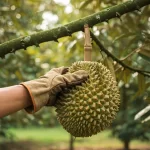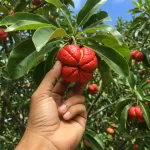Imagine a crisp winter morning, sunlight dappling through the branches of a majestic tree, revealing clusters of pearly white berries nestled amongst evergreen foliage. This enchanting sight isn’t a scene straight out of a fairytale; it’s the captivating beauty of mistletoe, a unique semi-parasitic plant that adds a touch of magic to the winter landscape. But unlike the readily available bunches sold during the holidays, cultivating your own mistletoe offers a sense of accomplishment and allows you to witness its fascinating growth cycle firsthand.
This comprehensive guide unveils the secrets to successfully growing mistletoe, even for gardening novices. We’ll delve into selecting the perfect host tree, explore propagation techniques, and provide essential care tips to ensure your mistletoe thrives for years to come. So, get ready to transform your garden into a winter wonderland adorned with this symbolic and visually captivating plant.
Let’s embark on this journey of cultivating your own enchanting mistletoe!
Choosing Your Mistletoe Match: A Match Made in Arboriculture
Just like soulmates, mistletoe thrives on finding the perfect partner – a suitable host tree. Different mistletoe species have evolved alongside specific trees, forming a symbiotic relationship. While the mistletoe gathers water and nutrients from its host, it doesn’t harm the tree in the process.
Selecting the right host is crucial for the success of your mistletoe endeavor. Here’s a glimpse into some popular pairings:
- European Mistletoe (Viscum album): This iconic variety prefers deciduous trees like apple, hawthorn, poplar, and lime.
- American Mistletoe (Phoradendron leucarpum): Found in North America, this species favors a wider range of hosts, including apple, crabapple, oak, and maple.
- Western Mistletoe (Phoradendron serotinum): This mistletoe is native to the western United States and Canada and often grows on a variety of deciduous trees like willow, cottonwood, and mesquite.
Remember: Always research the specific requirements of your chosen mistletoe variety to ensure compatibility with the trees in your garden.
The Berry Good Trick: Unveiling Mistletoe’s Natural Propagation
Unlike many flowering plants, propagating mistletoe from seeds is a slow and challenging process. Luckily, nature provides a simpler and more effective method – utilizing the plant’s very own berries!
Mistletoe berries, with their sticky white pulp, are designed for dispersal by birds. As feathered friends feast on these berries, the pulp deposits mistletoe seeds onto the bark of potential host trees. Inspired by this natural process, we can replicate it ourselves through a technique called “mashing.”
Here’s how to unlock the magic within the berries:
- Gather fresh mistletoe berries from a mature plant during late winter or early spring. Ensure the berries are plump and white, not wrinkled or brown.
- Carefully mash the berries with a gloved hand or a spoon. This breaks down the sticky pulp, revealing the seeds nestled inside.
- Select a healthy branch on your chosen host tree, ideally on the underside and away from the main trunk. This allows for better light penetration and minimizes competition with the host tree’s foliage.
- Apply the mashed berry pulp directly onto the bark of the chosen branch. Gently press the pulp to ensure good contact.
Pro Tip: Repeat this process on several branches to increase your chances of successful germination. Mother Nature might take her time, but with a little patience, you’ll witness tiny mistletoe seedlings emerge from the mashed berry pulp in the following spring.
Finding the Perfect Place: A Spotlight on Mistletoe’s Ideal Habitat
Now that you’ve unlocked the secrets of propagation, it’s time to find the perfect spot for your fledgling mistletoe to flourish. Remember, mistletoe isn’t your typical garden flower; it thrives in a slightly different environment.
Here’s a breakdown of the key factors to consider when choosing a location:
Light: Mistletoe prefers dappled sunlight. Avoid areas with full sun exposure, as this can scorch the delicate leaves. Conversely, excessively shady locations might hinder growth. Look for branches that receive a few hours of morning or afternoon sun, with some shade throughout the day.
Temperature: Most mistletoe varieties favor mild climates with cool winters and warm summers. However, some species can tolerate colder temperatures. Research the specific needs of your chosen mistletoe to ensure it thrives in your region’s climate.
Moisture: While mistletoe doesn’t require constant watering, it appreciates consistent moisture levels. Aim for a location that receives regular rainfall or provides easy access for occasional watering during dry spells.
The Art of Patience: Witnessing the Magic of Mistletoe Growth
Unlike fast-growing annuals, mistletoe rewards gardeners with its unique growth cycle. Patience is key when cultivating this fascinating plant. Here’s a glimpse into what to expect:
- Germination: After applying the mashed berry pulp, it can take several months for germination to occur. Don’t be discouraged by the wait! Mistletoe seeds require a specific set of conditions to sprout.
- Early Stages: Once germinated, the young mistletoe will slowly establish itself on the host tree. In the first few years, growth will be minimal, with only a small tuft of green leaves appearing.
- Maturity: Be prepared to wait several years before witnessing the full beauty of your mistletoe. It can take anywhere from 5 to 10 years for the plant to mature and produce its signature white berries.
Remember: Patience is a virtue! While the wait might seem long, witnessing the transformation from a tiny speck to a flourishing mistletoe plant is a truly rewarding experience.
Mistletoe Maintenance Made Easy: Keeping Your Enchantment Alive
Mistletoe isn’t a high-maintenance plant, but providing basic care will ensure it thrives for years to come. Here’s a breakdown of what your enchanting mistletoe needs to flourish:
- Watering: While mistletoe obtains some moisture from its host tree, it still appreciates occasional watering during dry periods. A deep soak every few weeks during the summer months is sufficient.
- Fertilizing: Mistletoe doesn’t require regular fertilization. However, a light application of balanced fertilizer once a year in early spring can provide a slight boost.
- Pruning: Extensive pruning isn’t necessary for mistletoe. However, you can carefully remove any dead or diseased branches to maintain the overall shape of the plant.
Pro Tip: Avoid pruning mistletoe during winter, as this can damage its delicate leaves and berries.
By following these simple care tips, you can ensure your mistletoe thrives for years to come, adding a touch of winter magic to your garden and becoming a cherished part of your winter landscape.
Beyond the Berries: The Ecological Significance of Mistletoe
While mistletoe’s captivating berries and evergreen foliage are undeniable draws, this plant plays a fascinating role in the ecosystem. Here’s a glimpse into its ecological significance:
- Food Source: Mistletoe berries provide a valuable food source for various bird species, including thrushes, pigeons, and blackbirds. These birds feast on the berries, aiding in seed dispersal and promoting the spread of mistletoe to new host trees.
- Habitat Creation: Mistletoe’s dense foliage creates a safe haven for smaller birds and insects. This provides additional nesting and foraging opportunities, contributing to the biodiversity of the surrounding environment.
- Nutrient Cycling: Mistletoe plays a role in nutrient cycling within the ecosystem. By extracting water and nutrients from its host tree, it adds organic matter to the forest floor as leaves and branches decompose, enriching the soil.
Understanding the ecological significance of mistletoe adds another layer of appreciation for this unique plant. It’s a reminder of the interconnectedness of nature and the vital role each species plays in maintaining a healthy ecosystem.
Unveiling the Myths and Legends: Mistletoe’s Rich History and Symbolism
Mistletoe’s presence transcends mere aesthetics and ecological significance. Throughout history, this plant has been shrouded in myths, legends, and cultural symbolism. Here’s a glimpse into its fascinating past:
- Celtic Lore: The Celts revered mistletoe as a symbol of peace, love, and fertility. They believed it held magical properties and used it in winter solstice rituals to promote good fortune and harmony.
- Scandinavian Mythology: In Norse mythology, mistletoe played a role in the story of Baldr, the god of light and joy. Mistletoe was the only weapon that could harm Baldr, ultimately leading to his death. However, through the intervention of the goddess Frigg, Baldr was resurrected, and mistletoe became a symbol of love and reconciliation.
- Holiday Traditions: Today, mistletoe is most commonly associated with Christmas traditions. The custom of kissing under mistletoe is believed to have originated in Europe and symbolizes love, romance, and good luck.
Understanding the rich history and symbolism surrounding mistletoe adds to its allure. It’s a reminder of the deep connection humans have with the natural world and the stories we weave around the plants that grace our landscapes.
Conclusion: Cultivating Your Own Enchanting Mistletoe Legacy
Cultivating your own mistletoe isn’t just about adding a unique winter accent to your garden; it’s about embarking on a journey of discovery. From unraveling the secrets of propagation to witnessing its fascinating growth cycle, nurturing mistletoe allows you to connect with the natural world on a deeper level.
As the years pass, your mistletoe plant will mature, becoming a cherished part of your winter landscape. Its captivating berries and evergreen foliage will not only add a touch of magic to your garden but also serve as a reminder of the ecological significance of this unique plant and the rich history and symbolism it embodies.
So, why not embrace the challenge and cultivate your own enchanting mistletoe legacy? With a little patience and the knowledge gleaned from this guide, you can unlock the secrets of this fascinating plant and witness its magic unfold in your own backyard.
Remember, gardening is a journey, not a destination. Enjoy the process of cultivating your mistletoe and celebrate the beauty and wonder it brings to your winter landscape.







